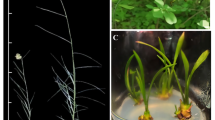Abstract
Many Anoectochilus plants are now facing extinction; hence, they are propagated mainly from tissue culture. However, growth performance and secondary metabolites have not been fully identified on tissue-cultured plantlets from multiple Anoectochilus species under shading. In the present study, five Anoectochilus species [A. roxburghii (Wall.) Lindl., Fu_1; A. koshuaensis Hayata, Fu_2; A. formosanus Hayata, Tai; un-identified species of Fu_New_1 and Fu_New_2] were generated from micropropagated plantlets and cultured under shade treatments of three levels (mean light intensities: mild, ~2000 Lx; medium, ~800 Lx; intensive, ~440 Lx) for five months. Among the five Anoectochilus species, the Tai and Fu_New_1 species had the highest survival rate and the Tai species had the best performance of stem morphology and foliar kaempferol content in the medium shade treatment, but it had fewer leaves and lower ratio of quercetin/kaempferol than the Fu_1 species. The Fu_New_2 species had the greatest biomass accumulation and highest content of total flavonoids, especially under the mild shade treatment. Therefore, among the Anoectochilus species tested in this study, A. formosanus is suggested to be used in continuous propagation, A. roxburghii is suggested to be planted in stressed environment, and the new species of Fu_New_2 is suggested to be planted for the production of flavonoids. Mild and medium levels of shading are suggested to be used when biomass production and fast growing are needed for Anoectochilus plantlets, respectively.




Similar content being viewed by others
References
Ajalla ACA, Vieira MD, Volpe E, Zarate NAH (2014) Seedling growth of Campomanesia adamantium (Cambess.) O. Berg (guavira), under three levels of shade and substrates. Rev Bras Frutic 36:449–458. doi:10.1590/0100-2945-196/13
Chang CJ, Wu SM, Yang PW (2000) High-pressure carbon dioxide and co-slovent extractions of crude oils from plant materials. Innov Food Sci Emerg 1:187–191. doi:10.1016/S1466-8564(00)00016-3
Cui SC, Yu J, Zhang XH, Cheng MZ, Yang LW, Xu JY (2013) Antihyperglycemic and antioxidant activity of water extract from Anoectochilus roxburghii in experimental diabetes. Exp Toxicol Pathol 65:485–488. doi:10.1016/j.etp.2012.02.003
Cushman KE, Maqbool M, Lata H, Bedir E, Khan KA, Moraes RM (2005) Podophyllotoxin content and yield of American mayapple leaves in sun and shade. HortScience 40:60–63
Dombroskie SL, Aarssen LW (2012) The leaf size/number trade-off within species and within plants for woody angiosperms. Plant Ecol Evol 145:38–45. doi:10.5091/plecevo.2012.665
Du XM, Irino N, Furusho N, Hayashi J, Shoyama Y (2008) Pharmacologically active compounds in the Anoectochilus and Goodyera species. J Nat Med 62:132–148. doi:10.1007/s11418-007-0169-0
Farhan M, Razak SA, Pin KY, Chuah AL (2012) Antioxidant activity and phenolic content of different parts of Orthosiphon stamineus grown under different light intensities. J Trop For Sci 24:173–177
Jaakola L, Hohtola A (2010) Effect of latitude on flavonoid biosynthesis in plants. Plant Cell Environ 33:1239–1247. doi:10.1111/j.1365-3040.2010.02154.x
Koop CE (2002) The future of medicine. Science 295:233. doi:10.1126/science.295.5553.233
Li B, Tang MJ, Tang K, Zhao LF, Guo SX (2012) Screening for differentially expressed genes in Anoectochillus roxburghii (Orchidaceae) during symbiosis with the mycorrhizal fungus Epulorhiza sp. Sci China Life Sci 55:164–171. doi:10.1007/s11427-012-4284-0
Liu Q, Ha W, Liu ZL, Xu J, Tian YL, Zhou XW, Mu XP (2014) 3-Hydroxybutanolide derivatives and flavonoid glucosides from Anoectochilus roxburghii. Phytochem Lett 8:109–115. doi:10.1016/j.phytol.2014.02.013
Ma ZQ, Li SS, Zhang MJ, Jiang SH, Xiao YL (2010) Light intensity affects growth, photosynthetic capability, and total flavonoid accumulation of Anoectochilus plants. HortScience 45:863–867
Majer P, Neugart S, Krumbein A, Schreiner M, Hideg É (2014) Single oxygen scavenging by leaf flavonoids contributes to sunlight acclimation in Tilia platyphyllos. Environ Exp Bot 100:1–9. doi:10.1016/j.envexpbot.2013.12.001
Paez A, Gebre GM, Gonzalez ME, Tschaplinski TJ (2000) Growth, soluble carbohydrates, and aloin concentration of Aloe vera plants exposed to three irradiance levels. Environ Exp Bot 44:133–139. doi:10.1016/S0098-8472(00)00062-9
Pinto JEBP, Cardoso JCW, de Castro EM, Bertolucci SKV, de Melo LA, Dousseau S (2007) Morphophysiological aspects and essential oil content in Brazilian-lavender as affected by shadowing. Hortic Bras 25:210–214
Rhie YH, Lee SY, Jun HH, Kim KS (2014) Light intensity influences photosynthesis and crop characteristics of Jeffersonia dubia. Korean J Hortic Sci Technol 32:584–589. doi:10.7235/hort.2014.14028
Shao QS, Wang HZ, Guo HP, Zhou AC, Huang YQ, Sun YL, Li MY (2014a) Effects of shade treatments on photosynthetic characteristics, chloroplast ultrastructure, and physiology of Anoectochilus roxburghii. PLoS ONE 9:e85996. doi:10.1371/journal.pone.0085996
Shao QS, Zhou AC, Hu RH, Zhang YY, Liu TM, Li MY (2014b) Influence of seedling grade on plant growth, yield and quality of Anoectochilus roxburghii. China J Chin Mater Med 39:785–789 (in Chinese)
Talukdar MC, Bora A (2009) Effect of substrates, poly-tunnels and growing conditions on hardening of in vitro raised carnation plantlets. Indian J Hortic 66:225–228
Tseng CC, Shang HF, Wang LF, Su B, Hsu CC, Kao HY, Cheng KY (2006) Antitumor and immunostimulating effects of Anoectochilus formosanus Hayata. Phytomedicine 13:366–370. doi:10.1016/j.phymed.2004.01.016
Wang YJ, Meng ZX, Yu XM, Wang CL, Guo SX (2009) Screening of endophytic fungi promoting growth and development of Anoectochillus roxburghii. Chin Pharm J 44:976–979 (in Chinese)
Zhang YH, Cai JY, Ruan HL, Pi HF, Wu JZ (2007) Antihyperglycemic activity of kinsenoside, a high yielding constituent from Anoectochilus roxburghii in streptozotocin diabetic rats. J Ethnopharmacol 114:141–145. doi:10.1016/j.jep.2007.05.022
Zhang AL, Wang HZ, Shao QS, Xu MJ, Zhang WS, Li MY (2015) Large scale in vitro propagation of Anoectochilus roxburghii for commercial application: pharmaceutically important and ornamental plant. Ind Crop Prod 70:158–162. doi:10.1016/j.indcrop.2015.03.032
Acknowledgements
This study was financially supported by the program of Plan of Science and Technology Developments in Hangzhou (Grant No. 20140932H21).
Author information
Authors and Affiliations
Corresponding author
Rights and permissions
About this article
Cite this article
Chen, C., Luo, X., Jin, G. et al. Shading effect on survival, growth, and contents of secondary metabolites in micropropagated Anoectochilus plantlets. Braz. J. Bot 40, 599–607 (2017). https://doi.org/10.1007/s40415-017-0365-4
Received:
Accepted:
Published:
Issue Date:
DOI: https://doi.org/10.1007/s40415-017-0365-4




